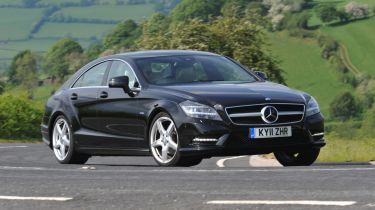Mercedes CLS 350 CDI
It’s the car that created this class, but have rivals caught up with the CLS?
If BMW wants to gain the upper hand in the increasingly busy four-door coupe market, this is the car it will have to beat. The Mercedes CLS is now in its second evolution, and builds on the strengths of its predecessor, which proved a surprise hit for the brand first time around.
Based on the platform and running gear of the E-Class saloon, the CLS is a more complex package than its predecessor. If you loved the original for its clean, flowing lines, there’s a chance that the current version’s bulges and sharp edges may leave you cold. When parked alongside the 6 Series Gran Coupe during our test, certain elements did look a little fussy.
With the exception of a few minor styling tweaks the cabin is carried over from the E-Class saloon, which is no bad thing. The seats are comfortable – and ours came with the £1,310 option of dynamic bolsters which hold you in when cornering – while the column-mounted gearshift is easy to live with and frees up space for the intuitive COMAND infotainment control system.
In an effort to distance it from the E-Class, Mercedes offers the CLS only with seating for two in the back. Although this means each rear occupant gets a more sculpted chair, the oversized armrest that runs the full length of the car confines passengers’ legs strictly to the area behind the front seats. This, combined with the low roofline and chunky door furniture, means that six-footers will find the back of the car rather cramped.
Used - available now

2023 Ford
Kuga
47,524 milesAutomaticPetrol2.5L
Cash £19,300
2020 Land Rover
Range Rover Velar
63,000 milesAutomaticDiesel3.0L
Cash £25,995
2020 BMW
X3
48,000 milesAutomaticDiesel2.0L
Cash £23,995
2020 BMW
X3
40,700 milesAutomaticDiesel3.0L
Cash £33,995Another area where the CLS disappoints is quality. Overall the cabin feels solid and upmarket, but some elements of the dash trim – notably the rotary controls for the heating – seem disappointingly cheap. On the plus side, the CLS boasts the biggest boot of our test trio with a volume of 520 litres.
Unlike BMW, Mercedes doesn’t reserve special engine options solely for the CLS range. The 265bhp 3.0-litre CDI diesel and standard seven-speed automatic box will be familiar to owners of other Mercedes, and the car proves a fair match for the more powerful BMW, recording a 0-60mph time that’s only half-a-second slower. It also feels quicker and more eager to accelerate than the Gran Coupe, particularly from low speeds.
Away from the track, our CLS didn’t seem quite as sharp as its rivals. It’s composed and capable through a series of turns, but the steering feels over-assisted, particularly at low speeds. And despite our car’s £1,500 optional air-suspension, the ride wasn’t quite as supple as the smooth BMW’s.
However, the Mercedes looks something of a bargain against the competition here. Even after you’ve added creature comforts such as air-suspension, dynamic massage seats and upgraded leather trim, you’ll still be paying thousands less than you would for the BMW or Porsche.
So while the CLS isn’t perfect, with such a significant price advantage it’s easy to overlook the car’s few failings.
Details
Chart position: 1Why? The CLS is now in its second generation, and remains the benchmark car in its class. This could be its stiffest test to date.







